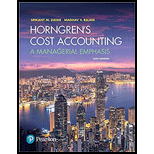
EBK HORNGREN'S COST ACCOUNTING
16th Edition
ISBN: 9780134475998
Author: Rajan
Publisher: YUZU
expand_more
expand_more
format_list_bulleted
Concept explainers
Textbook Question
Chapter 16, Problem 16.19MCQ
Dallas Company produces joint products, TomL and JimmyJ, each of which incurs separable production costs after the splitoff point. Information concerning a batch produced at a $200,000 joint cost before splitoff follows:
| Separable | Sales | |
| Product | Costs | Value |
| TomL | $10,000 | $ 80,000 |
| JimmyJ | 20,000 | 50,000 |
| $30,000 | $130,000 |
What is the joint cost assigned to TomL if costs are assigned using relative net realizable value?
- 1. $60,000
- 2. $140,000
- 3. $48,000
- 4. $200,000
Expert Solution & Answer
Want to see the full answer?
Check out a sample textbook solution
Students have asked these similar questions
gross profit percentage for this period?
Comprehensive income
I want to correct answer general accounting question
Chapter 16 Solutions
EBK HORNGREN'S COST ACCOUNTING
Ch. 16 - Give two examples of industries in which joint...Ch. 16 - What is a joint cost? What is a separable cost?Ch. 16 - Distinguish between a joint product and a...Ch. 16 - Why might the number of products in a joint-cost...Ch. 16 - Provide three reasons for allocating joint costs...Ch. 16 - Why does the sales value at splitoff method use...Ch. 16 - Prob. 16.7QCh. 16 - Distinguish between the sales value at splitoff...Ch. 16 - Give two limitations of the physical-measure...Ch. 16 - How might a company simplify its use of the NRV...
Ch. 16 - Why is the constant gross-margin percentage NRV...Ch. 16 - Managers must decide whether a product should be...Ch. 16 - Prob. 16.13QCh. 16 - Describe two major methods to account for...Ch. 16 - Why might managers seeking a monthly bonus based...Ch. 16 - Prob. 16.16MCQCh. 16 - Joint costs of 8,000 are incurred to process X and...Ch. 16 - Houston Corporation has two products, Astros and...Ch. 16 - Dallas Company produces joint products, TomL and...Ch. 16 - Earls Hurricane Lamp Oil Company produces both A-1...Ch. 16 - Joint-cost allocation, insurance settlement....Ch. 16 - Joint products and byproducts (continuation of...Ch. 16 - Net realizable value method. Sweeney Company is...Ch. 16 - Alternative joint-cost-allocation methods,...Ch. 16 - Alternative methods of joint-cost allocation,...Ch. 16 - Prob. 16.26ECh. 16 - Joint-cost allocation, sales value, physical...Ch. 16 - Joint-cost allocation: Sell immediately or process...Ch. 16 - Accounting for a main product and a byproduct....Ch. 16 - Joint costs and decision making. Jack Bibby is a...Ch. 16 - Joint costs and byproducts. (W. Crum adapted)...Ch. 16 - Methods of joint-cost allocation, ending...Ch. 16 - Alternative methods of joint-cost allocation,...Ch. 16 - Comparison of alternative joint-cost-allocation...Ch. 16 - Joint-cost allocation, process further or sell....Ch. 16 - Joint-cost allocation. SW Flour Company buys 1...Ch. 16 - Further processing decision (continuation of...Ch. 16 - Joint-cost allocation with a byproduct. The...Ch. 16 - Byproduct-costing journal entries (continuation of...Ch. 16 - Joint-cost allocation, process further or sell....Ch. 16 - Prob. 16.41PCh. 16 - Prob. 16.42PCh. 16 - Methods of joint-cost allocation, comprehensive....
Knowledge Booster
Learn more about
Need a deep-dive on the concept behind this application? Look no further. Learn more about this topic, accounting and related others by exploring similar questions and additional content below.Similar questions
arrow_back_ios
SEE MORE QUESTIONS
arrow_forward_ios
Recommended textbooks for you

 AccountingAccountingISBN:9781337272094Author:WARREN, Carl S., Reeve, James M., Duchac, Jonathan E.Publisher:Cengage Learning,
AccountingAccountingISBN:9781337272094Author:WARREN, Carl S., Reeve, James M., Duchac, Jonathan E.Publisher:Cengage Learning, Accounting Information SystemsAccountingISBN:9781337619202Author:Hall, James A.Publisher:Cengage Learning,
Accounting Information SystemsAccountingISBN:9781337619202Author:Hall, James A.Publisher:Cengage Learning, Horngren's Cost Accounting: A Managerial Emphasis...AccountingISBN:9780134475585Author:Srikant M. Datar, Madhav V. RajanPublisher:PEARSON
Horngren's Cost Accounting: A Managerial Emphasis...AccountingISBN:9780134475585Author:Srikant M. Datar, Madhav V. RajanPublisher:PEARSON Intermediate AccountingAccountingISBN:9781259722660Author:J. David Spiceland, Mark W. Nelson, Wayne M ThomasPublisher:McGraw-Hill Education
Intermediate AccountingAccountingISBN:9781259722660Author:J. David Spiceland, Mark W. Nelson, Wayne M ThomasPublisher:McGraw-Hill Education Financial and Managerial AccountingAccountingISBN:9781259726705Author:John J Wild, Ken W. Shaw, Barbara Chiappetta Fundamental Accounting PrinciplesPublisher:McGraw-Hill Education
Financial and Managerial AccountingAccountingISBN:9781259726705Author:John J Wild, Ken W. Shaw, Barbara Chiappetta Fundamental Accounting PrinciplesPublisher:McGraw-Hill Education


Accounting
Accounting
ISBN:9781337272094
Author:WARREN, Carl S., Reeve, James M., Duchac, Jonathan E.
Publisher:Cengage Learning,

Accounting Information Systems
Accounting
ISBN:9781337619202
Author:Hall, James A.
Publisher:Cengage Learning,

Horngren's Cost Accounting: A Managerial Emphasis...
Accounting
ISBN:9780134475585
Author:Srikant M. Datar, Madhav V. Rajan
Publisher:PEARSON

Intermediate Accounting
Accounting
ISBN:9781259722660
Author:J. David Spiceland, Mark W. Nelson, Wayne M Thomas
Publisher:McGraw-Hill Education

Financial and Managerial Accounting
Accounting
ISBN:9781259726705
Author:John J Wild, Ken W. Shaw, Barbara Chiappetta Fundamental Accounting Principles
Publisher:McGraw-Hill Education
Cost Accounting - Definition, Purpose, Types, How it Works?; Author: WallStreetMojo;https://www.youtube.com/watch?v=AwrwUf8vYEY;License: Standard YouTube License, CC-BY